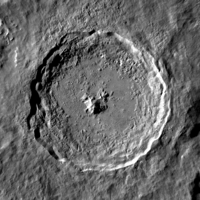
Photo from wikipedia
Abstract This paper considers depth/diameter ratios and values of maximum inner slopes of two groups of relatively small secondary impact craters on the Moon associated with the 800 Ma old… Click to show full abstract
Abstract This paper considers depth/diameter ratios and values of maximum inner slopes of two groups of relatively small secondary impact craters on the Moon associated with the 800 Ma old Copernicus crater and 100 Ma old Tycho crater. Secondary craters have the same formation age as their primary craters, but different sizes. This enables the study of how the rate of morphologic evolution of small craters depends on the crater size. Using the high-resolution images obtained by Lunar Reconnaissance Orbiter Camera we selected 15 craters of ∼350–950 m and 8 craters ∼250–650 m in diameter being secondaries of Copernicus and Tycho, respectively, and measured their depth/diameter ratios and maximum angles of crater inner slopes. Analysis of the measurement results showed distinct dependence of craters' morphologic degradation with time on their sizes. Assuming that the pristine craters are geometrically similar, we conclude that larger craters degrade slower. Application of the model of topographic diffusion to our observations showed that the modeling results reasonably agree with observations for the crater relative depths suggesting that the time scale of crater elimination is proportional to the square of the crater diameter. Meanwhile, for the crater inner slope steepness, the agreement of the model to observations is not so good, which demands additional studies.
Journal Title: Planetary and Space Science
Year Published: 2018
Link to full text (if available)
Share on Social Media: Sign Up to like & get
recommendations!